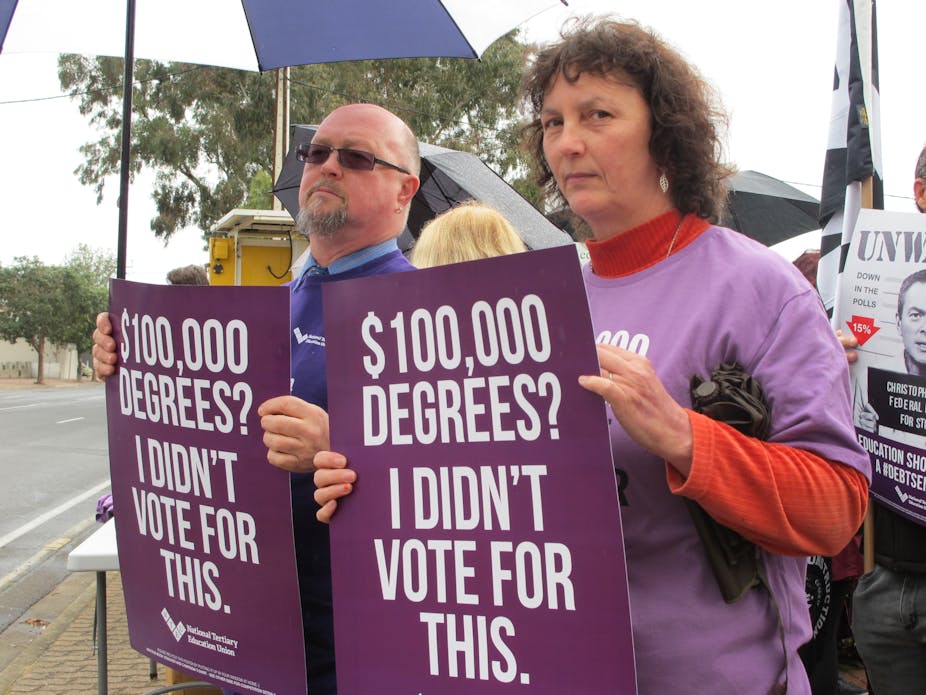The government’s proposed changes to higher education are a platform on which Labor can fight the next election.
The strategy is simple: don’t try to modify the package, or offer new solutions. Just shoot it down and let the Coalition wear it as a badge of broken promises and bad ideology. As Labor Senator Kim Carr confirmed at a recent Melbourne conference:
That will be an election issue. Labor will make it one.
Labor recently launched a campaign warning against “$100,000 degrees” under fee deregulation. It presents an online HELP debt calculator and some case studies so students can see how much more they would pay.
The problem is that the ALP’s “debt sentence” case studies are misleading.

Do universities plan to offer $100,000 degrees?
Until the reforms are ruled in or out, universities can’t plan. But plan they must. The first step is to define “breakeven” prices so that fee rises offset the planned cuts to course funding. Conor King of the Innovative Research Universities group estimates that sector-wide, a single breakeven price for all students in 2016 dollars would be about $10,400.
The next step is to decide on a pricing strategy. Many universities will aim to lift teaching budgets above breakeven. To lift fee revenue by 15%, a “typical” university would need to price its courses at about A$12,000 a year on average. A A$14,000 average would lift net fee revenue by 35%, a A$16,000 average by 55% and an A$18,000 average by 75%.
For students, the price hike effect will depend on the field of study.
In 2016 dollars, today’s three regulated fee caps are A$6300 a year in low-priced courses, A$9000 in the middle and A$10,500 at the high end. With fee deregulation, if all bachelor courses were priced at A$16,000 – as announced recently by the University of Western Australia – the price rise would be 55% for commerce students, 75% for science students and 155% for arts students.
For most universities, a single price point for all courses won’t work. The cost of delivering the course, how much subsidy the university receives from government per course and the different levels of income graduates are likely to expect all vary too widely from field to field. Nor will it make sense to match fee increases to subsidy cuts. These also vary widely, from zero in some fields to 50% in others.
With fee deregulation, a new three-level price structure could work for many universities. With a A$9,000-$11,000-$13,000 structure the average fee per student per year in a “typical” university would be less than A$11,000. As shown in the table below, this lifts fee revenue by about 5% above breakeven. The price hike for students ranges from 25% in law or engineering to 45% in arts or nursing. At the lower end, a A$8,000-$10,000-$12,000 structure would put revenue around 5% below breakeven, but still lift prices by 10%-30%.

A university could lift net fee revenue by 40% with a A$12,000-$15,000-$18,000 structure. This would still keep fee increases below 100% in all fields. However, to lift revenue by 65%, a A$15,000-$18,000-$21,000 structure would lift all prices by 100% or more.
But, even if fee revenue rises by 75%, the most expensive three- and four-year degrees can still be priced at less than A$100,000. On this view, if most universities aim for breakeven plus a modest surplus, A$100,000 degrees will be rare.
How Labor calculates $100,000 degrees
The ALP’s case studies seek to show debt repayments under the government’s proposed changes. These claim to predict the full cost impact of the reforms for a typical student. So a science degree for “Sean” will cost A$118,781 and a business degree for “Timara” will cost A$126,803.
In each case, a footnote confirms that all calculations are based on NATSEM modelling. This approach estimates both course fees and graduate income prospects. It then models annual HELP loan repayment patterns and interest charges. Along the way it factors in some non-repayment years for women taking time out of the workforce to care for children.

But what the ALP’s online HELP repayment calculator shows is that on NATSEM’s preferred assumptions, in most fields the real cost of a degree will be far less than A$100,000. Using NATSEM’s recommended interest rate of 5%, and its inflation-adjusted repayment calculations, in science a male graduate pays about A$74,000 in real terms. Still a substantial cost, as this assumes “worst case” not “best case” pricing for the course. On the same assumptions, a female business graduate pays about A$78,000.
What makes the ALP estimates so much higher? Each case study assumes an (undeclared) worst case tuition price. Then it applies an (undeclared) 6% interest rate. Then it presents the graduate’s total repayment in (undeclared) nominal dollars, without adjusting for inflation.
This makes the ALP’s “debt sentence” predictions very misleading. As ACU vice-chancellor Greg Craven quipped recently:
Many Australians now believe getting an arts degree will cost more than buying a Renoir.
If presented as a case study on ALP assumptions, an arts degree would cost a female graduate A$123,842. Who believes this?
Labor’s claim that “$100,000 degrees will be the norm” is even more far-fetched than the Coalition’s claim that bachelor degrees offer a “million dollar gain” for the average graduate.
As the Group of Eight pointed out recently, A$100,000 degrees already exist, but as rare exceptions. Under fee deregulation they are most likely to remain exceptional.

